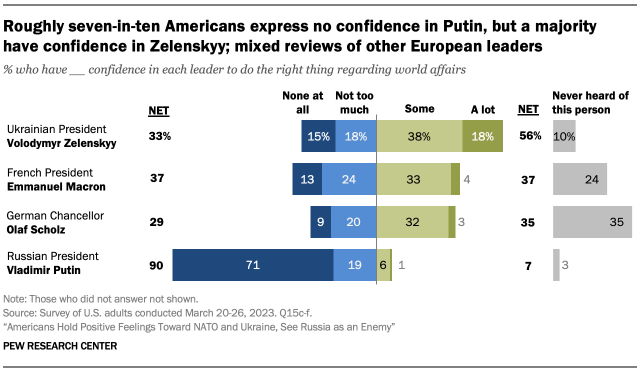In trying to figure out what will happen in 2024, we all understandably spend a lot of time talking about the candidates, the parties, the PACs—all of those entities shaping, or hoping to shape voters’ behaviors.
But we don’t spend nearly enough time or energy on the voters themselves. Partly, that is because it is hard to do. The electorate keeps the secrets that it doesn’t yield up to pollsters until Election Day. That’s partly because even the voters don’t know—sometimes especially the voters don’t know.
They don’t know because of the actions of the previously mentioned entities out there feverishly shaping, wheedling and cajoling. Asking a politically persuadable American which candidate he or she would prefer assumes that the voter a) knows and b) cares who Gov. Whatshisname or Sen. Whosywhatsit is and what they’re saying or doing about the scourge of immoral advertising for terrible light beers or the regulation of chatbots.
Opinion polls this far from an election are measuring the opinions of the disengaged but interpreted by the overly engaged. Hilarity often ensues.
So while the individuals and groups hoping to manipulate the electorate are very easy to cover—indeed, getting media attention is often the first component of their efforts—the object of their desires, the voters, remain hard to get at. Outside of the valuable on-the-ground reporting that tells us what is happening at the precinct level, there are few ways during this long predawn period to really see where voters are and where they might be going.
Special and off-year elections, like the ones this week in Florida, Colorado, Pennsylvania, and Kentucky, can give us insights on the electorate. But these function as little core samples; small enough to be ambiguous but still large enough to project all your pre-existing assumptions upon.
We tell ourselves a story about the electorate and, no surprise, find it confirmed in the gray scribbles of the chiaroscuro of election results and polls.
But sometimes, we get lucky.
It takes until the spring of the year following an election for all of the voter file data to be stacked and sorted. Exit polls tell us something, but it’s in the same messy scrawl as most of the other data we have. Voter files, though, tell analysts what really happened. And now we have the goods on 2022, thanks to the data gurus at Catalist.
Last year’s midterm is worth studying for itself because it broke so many rules. The expected outcome was that the midterm curse would afflict the party in power as it has in every president’s first midterm the last 90 years except for George W. Bush in the aftermath of 9/11. With an unpopular president and a discontented electorate, the party in power should have been in for a shellacking.
Instead, we saw something like the 1960 contest, in which the party in power was spared the expected disaster by the Cuban Missile Crisis in October. Voters back then rallied to John F. Kennedy, who was adjudged to have passed the test of leadership (with the help of his Republican predecessor). But President Biden didn’t stave off nuclear war in the fall of 2022. He remained a drag on his party in key districts. So what happened?
The answer matters for history, yes, but also very much for the present. Voters’ prior behavior remains the best predictor of future elections, and while midterm elections are different in character from presidential years, they show us a very useful picture of the two-thirds or so of the electorate most likely to vote in 2024.
Here is a key key findings from the Catalist analysis:
“From the late 1970s to the early 2000s, young Democratic support was routinely between 50% and 60% and even dropped below 50% in some cycles. This marks the first time that young people’s Democratic support has been greater than 60% for two consecutive midterm elections, and now includes a midterm with a Democratic incumbent president.”
If you’re a Democrat this is truly great news. It indicates that two favorable trends, one demographic and the other situational, are working together to your party’s advantage.
The demographic advantage for Democrats is not that younger voters have been more Democratic than previous generations, but that they stay Democratic for longer. This can be explained in part by the disruption of the assembly line for making Republican voters: Young Democrats marry, move to the suburbs, have kids and, presto, become more interested in issues that line up with the conservative party (taxes, public safety, etc.) and less interested in issues that favor the progressive party (abortion, social justice, etc.).
As more Americans remain single and childless for longer into adulthood, the old ways aren’t working for the GOP, especially with women. Remember, it’s not so much a gender gap as it is a marriage gap.
So what happens if as that trend is playing out, the Republican Party finds itself in the thrall of an elderly, demagogic game show host who makes his political living by agitating the fears and resentments of older, white voters?
This is why the stakes are so high for Republicans in 2024. The period between 1930 and 1944 so profoundly shaped younger generations’ identities as Democrats that it would take 50 years for Republicans to be reliably competitive in seeking control of the House of Representatives again. Or, more aptly for the GOP’s predicament, the capture of the Democratic Party by William Jennings Bryan and his fellow populists in the 1890s hobbled the blue team until the Panic of 1929 and Franklin Roosevelt.
Bad candidates and bad demographics can produce generational consequences for parties, and Republicans sure have both of those things lately.
The good news from the 2022 data if you’re a Republican is that the Democrats weren’t that good, it was that you were that bad:
Democrats actually improved their vote share among white non-college voters (36% in 2020 to 40% in 2022), while slightly losing support among white college voters (53% in 2020 to 51% in 2022). Directionally, in both cases, the relative improvement came among white non-college voters.
The conventional wisdom, to which I have often been a contributor, is that Democratic gains have come among affluent suburbanites who may lean Republican on many issues but can’t abide Trump and his chaotic corruption. And that’s certainly true, but it missed some key components.
Democrats saw their biggest gains in competitive statewide races with non-college women, probably in considerable part because of concerns around Republican restrictions of elective abortion. Republicans saw the most improvement from 2018 among college-educated men. And as for the much-discussed rightward shift in Hispanic voters in midterms? Meh. Democrats scored 62 percent of the vote compared to 61 percent in 2020.
That all adds up to this: It wasn’t that Democrats overperformed, it was that Republicans underperformed.
The suburbs are still very much available to Republicans, and Democrats still rely on a working-class, substantially non-white base. Mainstream GOP candidates can still win on the same issues that have been the party’s bread and butter for generations, which makes the ongoing reinvention of the GOP to conform to the electoral needs of the aforementioned demagogue seem even kookier.
Holy croakano! We welcome your feedback, so please email us with your tips, corrections, reactions, amplifications, etc. at STIREWALTISMS@THEDISPATCH.COM. If you’d like to be considered for publication, please include your real name and hometown. If you don’t want your comments to be made public, please specify.
STATSHOT
Biden Job Performance
Average approval: 41.6%
Average disapproval: 54.4%
Net score: -12.8 points
Change from one week ago: no change
Change from one month ago: ↑ 0.6 points
[Average includes: ABC News/Washington Post: 37% approve-56% disapprove; Fox News: 44% approve-55% disapprove; NPR/PBS/Marist: 43% approve-50% disapprove; CBS News: 43% approve-57% disapprove; Reuters/Ipsos: 41% approve-54% disapprove]
Polling Roulette

TIME OUT: HOW FIRM A FOUNDATION
Smithsonian Magazine: “Nearly all the United States’ greatest structures—the Empire State Building, the Washington National Cathedral, the Metropolitan Museum of Art, to name just a few—owe much of their grandeur to a humble source that keeps on giving: a band of limestone in south-central Indiana. This geological richness stretches back at least 345 million years, when the tropical waters of a warm inland sea ground up the remains of calcite-bearing invertebrates, forming carbonate sand—not the more common quartz sand—fated to lithify as some of the world’s most prized limestone. … Demand for limestone skyrocketed in the 1890s, after massive urban fires razed buildings across Chicago and Boston. Indiana limestone was the ideal rebuilding solution, flame-resistant and up to the country’s first building codes. … Architects and sculptors quickly came to love the stone—dubbed ‘the Nation’s Building Stone.’ … As the renowned architect Robert A.M. Stern once put it, Indiana limestone, ‘even on a gray day … seems to glow.’”
DESANTIS LOOKS FOR LAUNCH TO RECAPTURE MOMENTUM
New York Times: “Gov. Ron DeSantis of Florida all but declared his presidential candidacy on Thursday afternoon. … ‘You have basically three people at this point that are credible in this whole thing,’ Mr. DeSantis told donors on the Thursday afternoon call, organized by the super PAC supporting him, Never Back Down. ‘Biden, Trump and me. And I think of those three, two have a chance to get elected president—Biden and me. …’ Mr. DeSantis is expected to file paperwork declaring his candidacy with the Federal Election Commission ahead of a major fund-raising meeting with donors in Miami on May 25 that is meant to act as a show of his financial force. … He is also likely to release a video to coincide with his official entrance into the race, and a blitz of events in the early nominating states will follow in the weeks ahead.”
Trump stacks the deck with delegate rules: Bloomberg: “In 2024, more states will award delegates through winner-take-all primaries—a system that helped Trump when opponents divided the vote, allowing him to be awarded all or most of the delegates with less than majority support. Once in office, Trump used his influence to stack state parties with loyalists who increased the number of winner-take-all states from seven in 2016 to 17 in 2020. … The result is a system that could give Trump a head start on the nomination before the first contest is even held. … There’s still time for rival campaigns to lobby state parties for changes to their 2024 delegate selection plans, which must be submitted to the Republican National Committee by Oct. 1.”
New Hampshire endorsements get messy: Washington Post: “New Hampshire is the Claire’s of politics. Scoop your hand into the state legislature and you can come out with handfuls of supporters, releasing jaw-dropping press releases about the dozens of people who support you. … So it was that, last month, the campaign of former president Donald Trump scooped into the legislature and withdrew a hand bedazzled with more than 50 names. … But then, this week, a super PAC supporting the still-not-yet-formal candidacy of Florida Gov. Ron DeSantis (R) dipped its hand into the legislature as well. And, sure enough: bedazzlement. … There was just one problem. Four of the legislators adorning each campaign’s press release were also on the other campaign’s press release. … In one case, NBC News reported, the legislator simply endorsed both candidates. … In another case, the legislator retracted her endorsement of DeSantis.”
Scott staffs up before next week’s launch: Politico: “Tim Scott has tapped former Tennessee Gov. Bill Haslam as national co-chair of his imminent presidential campaign, part of a slate of nationwide and homestate allies the South Carolina senator is assembling ahead of his launch next week. … Haslam, who in office gained a reputation as a pragmatic conservative willing, at times, to speak out against Donald Trump, served as chair of the Republican Governors Association from 2017 to 2018. … The former governor’s decision to get on board with the campaign suggests Scott will secure support from high-profile Republicans beyond his colleagues in the Senate… It also opens the door for Scott to a new network of donors and relationships that Haslam, a billionaire himself, has at his disposal. … After launching an exploratory committee last month, Scott said he will make a formal announcement May 22 in his hometown of North Charleston.”
Cash-rich Scott drops pricey ad buy in early states: AP: “Sen. Tim Scott of South Carolina plans to begin airing TV ads in Iowa and New Hampshire early next week. … The ad buy, valued at about $5.5 million, is scheduled to run through the first GOP presidential debate in late August and marks the most significant advertising expenditure by a potential or declared candidate in the early stages of the 2024 nominating campaign. … He would start a bid with more campaign dollars than any of his 2024 rivals—roughly $22 million that he can automatically convert from his U.S. Senate campaign account to a presidential campaign.”
Pence allies launch super PAC: Politico: “Former Texas Rep. Jeb Hensarling and veteran Republican strategist Scott Reed will co-chair a super PAC backing an expected Mike Pence presidential bid. The Committed to America PAC will help Pence, the former vice president, focus on early states… Bobby Saparow, Georgia Gov. Brian Kemp’s former campaign manager, will run the PAC.”
Kemp looks to play kingmaker, not seek the crown himself: The Dispatch: “A federal super PAC aligned with Gov. Brian Kemp plans to oversee a robust voter turnout operation in Georgia for the eventual Republican presidential nominee, The Dispatch has learned. … A Kemp adviser emphasized the governor might also put his political machine to work for a candidate in the primary, which will take place March 12 of next year. The ground-game plans are part of Kemp’s broader effort, dating back to last year’s midterm elections, to re-create the functions of the state Republican Party, which has attached itself to former President Donald Trump and struggled to fundraise in recent cycles. … Kemp has already said he is not running for president in 2024 and maintains his focus is centered on flipping Georgia red this presidential cycle, though his team concedes that ‘if hell freezes over’ and he’s getting encouragement to run, he could change course.”
Youngkin opens the door to presidential speculation: NBC News: “Gov. Glenn Youngkin, R-Va., released a broad campaign-style video on social media Thursday morning despite his repeated insistence he is not currently running for president. The one minute video, paid for by Youngkin’s state super PAC ‘Spirit of Virginia,’ shows clips from the governor’s recent speech at the Reagan library. … It also shows clips of Youngkin and his wife touring the Reagan library and stock images that evoke the launch of a campaign like a rising sun. … The ad is also designed to demonstrate his political characteristics that have resonated with Virginia voters as a way to help GOP candidates in the commonwealth’s upcoming competitive legislative races in the fall.”
Sununu edges toward 2024 launch: The Dispatch: “[New Hampshire Gov.] Chris Sununu is accelerating plans to run for president. … In telephone calls and in-person meetings, Sununu is pitching a potential White House bid to wealthy Republican donors in New Hampshire who have backed his four gubernatorial campaigns—and to top GOP financiers across the country. … If he runs, Sununu would enter the contest no later than June 30, he says. … The governor said his immediate family was on board with him running—a crucial development initially considered doubtful. Sununu also said that he has reached two important conclusions: He can raise the resources necessary to field a viable campaign; and he has a legitimate path to the nomination.”
And another one … : CBS News: “North Dakota Governor Doug Burgum is expected to make a decision within the next couple weeks. … Though there had been whispers in Republican circles in recent weeks over a possible Burgum candidacy after several GOP consultants had been approached by representatives for the North Dakota governor, his likely decision to move forward with a campaign came after the North Dakota legislative session ended earlier this month. … ‘That’ll be next, to think about 2024,’ Burgum said earlier this week to The Forum. ‘There’s a value to being underestimated all the time,’ Burgum said.”
And another one … : Politico: “Should [Miami Mayor Francis Suarez] enter the race for the GOP nomination, the son of former Miami Mayor Xavier Suarez would add an interesting dynamic to the contest. The two-term mayor, who currently heads the bipartisan U.S. Conference of Mayors, would be the only Latino in the field thus far. … ‘America is incredible,’ he said. ‘The country picks people that no one expects, oftentimes. Right?’”
BRIEFLY
Pennsylvania House stays with Dems after special election—Philadelphia Inquirer
Dems score mayoral upset in DeSantis’ backyard—Florida Times-Union
Colorado Springs elects first ever non-Republican mayor—Colorado Sun
WITHIN EARSHOT: LOOKING AT YOU, MEATBALL
“Let me just say, the Trump culture of winning is alive and well in Kentucky!”—Attorney General Daniel Cameron throws shade at Ron DeSantis after defeating the DeSantis-endorsed Kelly Craft in the Republican gubernatorial primary on Tuesday.
MAILBAG
“[Y]our reply to reader Earl King in the Mailbag section of your latest entry (‘Trump Raises the Rent on Republicans’) leads me to posit a scenario worth considering if only as a thought experiment. Suppose a centrist independent candidate emerges who’s way more popular than Biden and has gotten onto every state ballot. Would Biden step aside to avoid being a spoiler? A dilemma like this could face Ruben Gallego (or whichever Democratic wins the nomination) in the upcoming Arizona Senate race. Assuming Kyrsten Sinema seeks re-election, sophisticated polling next year may show that despite finishing last in a hypothetical three-way contest, she is actually better positioned than Gallego to defeat the Republican in a two-way race, given the strong aversion many voters have to the (D) brand. Especially if the (R) is a Trump fanatic like Kari Lake, Democrats in that case might face calls to let the incumbent (I) be the one to stand against MAGA this time around. At the same time, there’s reason to suppose that such a decision would anger a lot of (D) voters, leading them to sit out the election rather than vote for a candidate many feel has betrayed them over and again.”—Tom Johnson, Nashville, Tennessee
All good points, Mr. Johnson. And certainly you are right that Gallego’s strategy depends substantially on the Republicans fielding a nut as their nominee. A mainstream Republican would mean that Gallego and Sinema would be divvying up a smaller pool of voters and likely put the seat back in the red. As for what Biden would do if a third-party candidate became a sensation and was polling ahead of him in a race with Trump, there are a lot of variables to ponder there. But faced with a similar situation in the summer of 1992, George H.W. Bush stayed and fought and ultimately lost. One thing politicians generally struggle to do is believe that they are bound for defeat. The same ego and optimism that got them in the race in the first place tends to keep them there. I think that as long as Biden can still draw breath, he will keep running.
You should email us! Write to STIREWALTISMS@THEDISPATCH.COM with your tips, kudos, criticisms, insights, rediscovered words, wonderful names, recipes and, always, good jokes. Please include your real name—at least first and last—and hometown. Make sure to let me know in the email if you want to keep your submission private. My colleague, the doughty Nate Moore, and I will look for your emails and then share the most interesting ones and my responses here. Clickety clack!
CUTLINE CONTEST: UP TO HIS AULD TRICKS

You beautiful, hilarious weirdos! From time to time you guys exceed even my very high expectations for your humor, particularly in the category of the unpublished bawdy works. This week’s photo of former President Donald Trump on his way to play his company’s golf course in Scotland produced such a wave of comedic excellence that I will be chuckling all weekend on the residuals. Our winner, a veteran Cutline Contest competitor, obviously drew on his community’s deep connection to the greatest game:
“OK, I’m gonna need you to find me 12 strokes.”—Bill Ward, St. Augustine Beach, Florida
Winner, Quiet Luxury Division:
“Former President Trump demands a color scheme for Golf Cart One.”—Linda McKee, DuBois, Pennsylvania
Winner, Please Pull Up to the First Window Division:
“That’s three large pepperoni and a case of Bud Lite, right?”—Michael Smith, Georgetown, Kentucky
Winner, Legacy Gags Division:
“Get in, loser—we’re going losing!”—Daniel Summers, Knoxville, Tennessee
Winner, Even the Losers and the Haters Division:
“Follow me, I know a shortcut over the cliff.”—John Connelly, Salt Lake City, Utah
Winner, Follow the Science Division:
“I drive the best electric vehicles in Scotland. Nobody recharges their EV more often than I do when I’m on my world class golf course. I’m single-handedly drawing so many electrons from those off-shore, cancer-causing wind turbines that they’re going to have to build more of them.”—Andy Napoli, Arlington, Virginia
Winner, In the Bunker Division:
“The Saudis are begging me to join the LIV tour.”—Bob Goldman, Gilroy, California
Send your proposed cutline for the picture that appears at the top of this newsletter to STIREWALTISMS@THEDISPATCH.COM. We will pick the best entrants for each week and an appropriate reward for the best of this month—even beyond the glory and adulation that will surely follow. Be hilarious, don’t be too dirty, and never be cruel. Include your full name and hometown. Have fun!
CHARIOTS OF FIRE, BUT FOR DIAPERED DWARF GOATS
KTVI: “An all-state athlete was not allowed to participate in a regional [track and field] competition this weekend after she brought her pet goat to school … The goat is a Nigerian dwarf named Rachel. ‘Rachel is more of a pet than a goat,’ said a family friend. ‘She comes into the house all the time and wears a diaper when she’s inside. She has a harness and leash. She’s not the typical outside goat.’ A family friend said Farmington [Missouri] High School senior Jade Roth, who set a record high jump of 5 feet, 2 inches at a track meet, brought the goat before school. It was the senior’s last day for the year. Administrators told Roth to take the goat home and return to school. ‘When they came back to the school, they came to the office and were told they were being suspended for the day,’ said the family friend. ‘That being Jade’s last day of high school meant she was ineligible to compete in any extracurricular activities during the weekend, which unfortunately was the district track competition.’”
Chris Stirewalt is a contributing editor at The Dispatch, a senior fellow at the American Enterprise Institute, the politics editor for NewsNation, and author of Broken News, a book on media and politics. Nate Moore contributed to this report.







Please note that we at The Dispatch hold ourselves, our work, and our commenters to a higher standard than other places on the internet. We welcome comments that foster genuine debate or discussion—including comments critical of us or our work—but responses that include ad hominem attacks on fellow Dispatch members or are intended to stoke fear and anger may be moderated.
With your membership, you only have the ability to comment on The Morning Dispatch articles. Consider upgrading to join the conversation everywhere.